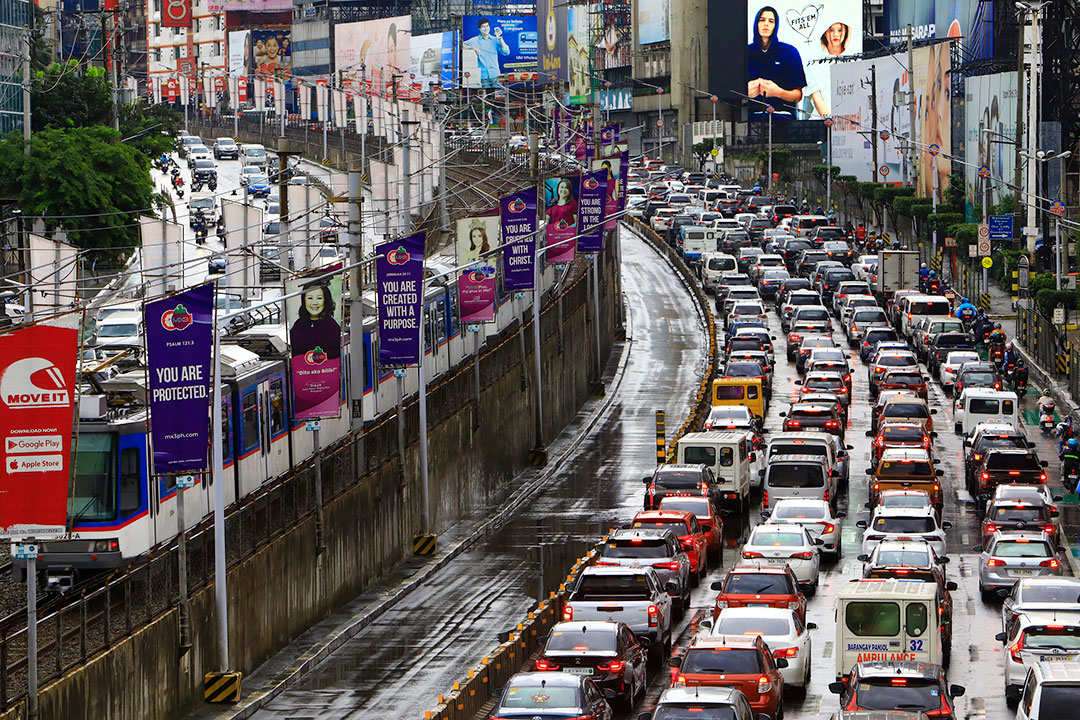 PHILIPPINE STAR/WALTER BOLLOZOS
PHILIPPINE STAR/WALTER BOLLOZOSBy Chloe Mari A. Hufana and Ashley Erika O. Jose, Reporters
PRESIDENT Ferdinand R. Marcos, Jr. on Sunday suspended the planned rehabilitation of Epifanio de los Santos Avenue (EDSA) that was originally set to start next week, citing the need for further studies to find a “better way” and reduce its expected impact on commuters, motorists, and broader economic activity, including potentially shortening the project’s duration.
The start of the P8.7-billion rehabilitation of Metro Manila’s busiest highway, which was set for June 13, has been deferred to July, although Mr. Marcos did not give a specific date.
The President made the announcement during his visit to the Metro Rail Transit Line-3 Kamuning Station in Quezon City, where he addressed sectors’ concerns over the project.
“Many people [complained] about the planned EDSA rehabilitation. A lot of people have come forward, expressing concern, saying things like, ‘What about our jobs?’” Mr. Marcos said in Filipino.
“When we look at the cost-benefit analysis, yes, it would be good if we could fix it, but the sacrifice required — two, three years — would be too much,” he added. “For now, it’s very clear that too many people will be burdened by the EDSA rehabilitation as it currently stands. We will find a better way — one that is not too difficult for our fellow citizens.”
He said the government is aware of the daily struggles of Filipino commuters and workers who rely on EDSA, which is used by around 400,000 vehicles daily and links key commercial and residential hubs across Metro Manila.
Apart from mobility concerns, Mr. Marcos said the government has been made aware of new technologies that were not considered in the initial planning of the EDSA rehabilitation, adding that he has already instructed the secretaries of the Transportation and Public Works and Highways departments to study these.
He also ordered relevant agencies to reassess the rehabilitation strategy and explore methods that could potentially reduce the construction timeline to as short as six months or one year from the original two-year timeline.
The Department of Transportation said in a statement that it is now working with its partner agencies to assess all available options to expedite the rehabilitation of the highway to reduce opportunity costs for motorists and commuters.
The Metropolitan Manila Development Authority said in a separate statement that it will no longer implement the odd-even scheme on EDSA following the rehabilitation project’s suspension. The existing number coding scheme will instead be in effect.
The EDSA rehabilitation forms part of the Marcos administration’s “Build Better More” infrastructure program, a key pillar of its economic strategy aimed at boosting productivity, reducing logistical bottlenecks, and supporting long-term growth.
The delay comes amid broader public apprehension over mounting traffic congestion in Metro Manila and the socioeconomic trade-offs of major infrastructure overhauls.
Rene S. Santiago, former president of the Transportation Science Society of the Philippines, said EDSA’s rehabilitation is “long overdue,” and another pause “merely kicks the can down the road.”
“There is a way to minimize the temporary pains,” he said in a Viber chat. “From available work plans, there is room for improvement, particularly on the Metropolitan Manila Development Authority side as well as the Department of Transportation.”
Meanwhile, Federation of Free Workers President Jose Sonny G. Matula welcomed the postponement of the project, calling it a sign of sensitivity from Mr. Marcos.
“Even if a project is designed by the best minds and aims to produce the best outcomes, it may still be rejected or misunderstood if the people are not consulted and do not feel a sense of ownership,” he said in a Viber chat.
The labor leader called on the government to review the EDSA facelift plan and conduct broad consultations with stakeholders, including labor groups, transport workers, and commuters, to adopt a phased, worker-friendly approach.
“The goal should be to modernize our infrastructure without sacrificing the welfare of the working public,” Mr. Matula added. “Progress should not come at the expense of the people. Let us build better roads but let us also protect the dignity and livelihood of every Filipino worker.”
IMPACT ON COMPANIES
Analysts last week said the EDSA rehabilitation project may have a short-term impact on revenues of conglomerates with businesses reliant on foot traffic like malls and entertainment, but their diversified income streams and large nationwide footprints will help soften the blow.
“Companies like SM Investments Corp. (SMIC) and Robinsons Land Corp. (RLC) which rely on mall visitors for revenue, could face a decline in foot traffic during the construction phase,” Globalinks Securities and Stocks, Inc. Head of Sales Trading Toby Allan C. Arce said in a Viber message.
The expected traffic congestion and prolonged roadworks might deter consumers from visiting malls, Mr. Arce said, which could lead to reduced retail sales, lower cinema attendance, and a possible decline in food and beverage revenues.
“Mall and entertainment operations may experience a short-term revenue dip as consumers adjust their habits, potentially recovering post-rehabilitation if improved infrastructure leads to greater accessibility and convenience,” Mr. Arce said.
Still, the expected reduction in foot traffic would not have a major impact on mall operators’ revenue streams, according to China Bank Capital Corp. Managing Director Juan Paolo E. Colet.
“Our preliminary assessment is that the rehabilitation work would not have a material financial impact on major mall operators with diverse and well-situated mall properties,” Mr. Colet said in a Viber message.
“Shoppers are likely to push some spending online or toward neighborhood centers, so the flagship EDSA malls like SM, Robinsons and other malls nearby should see softer weekend crowds. But I guess those malls make up only a slice of each group’s portfolio,” Seedbox Securities, Inc. equity trader Jayniel Carl S. Manuel likewise said in an e-mail.
SMIC, through its unit SM Prime Holdings, Inc. (SMPH), has 88 malls in the Philippines, with 25 located in Metro Manila.
For the first quarter, SMIC reported a 9.07% increase in its attributable net income to P20.05 billion from P18.39 billion last year.
It said that consumption will drive its long-term growth plans, led by its property, banking, and retail sectors.
Meanwhile, RLC has 55 malls nationwide, with only nine of these in Metro Manila.
The company recorded a 4% increase in its first-quarter attributable net income to P3.48 billion, while revenue was maintained at P11.03 billion.
RLC earlier said that it expects earnings to rise by 12% annually to achieve its 2030 target of delivering P25 billion in net income. As part of this goal, the company is looking to expand its investment portfolio, with plans to increase its mall gross leasable area.
The analysts said the expected increase in vehicular traffic could even present growth opportunities for companies as Filipinos adjust their spending and travel routines.
Globalinks Securities’ Mr. Arce said mobility challenges will likely accelerate online shopping, which companies with strong e-commerce platforms could benefit from.
For Seedbox Securities’ Mr. Manuel, traffic congestion could also propel the growth of property firms, which puts companies like SMPH and RLC in the position to capture the expected housing demand.
“The traffic crunch could actually lift earnings. I think many office workers are ready to pay for accommodation near Makati and Bonifacio Global City to dodge long commutes,” he said.
“EDSA-side malls give up a little near-term rent growth, but SMPH and RLC can claw much of it back through stronger residential and co-living revenues, while telcos enjoy a clear volume tailwind. For investors, the construction period looks more like a portfolio reshuffle than a real earnings cliff,” Mr. Manuel added.
Telecommunications and information and communications companies could also see a boost in revenues as mobility restrictions could lead to the return of remote work setups that could result in increased demand for connectivity, Mr. Arce likewise said.
“With consumers expected to spend more time at home and adopt work-from-home setups, there could be an uptick in demand for reliable internet and telecom services. This scenario favors telco companies,” he said.

 1 day ago
1
1 day ago
1













 English (US) ·
English (US) ·